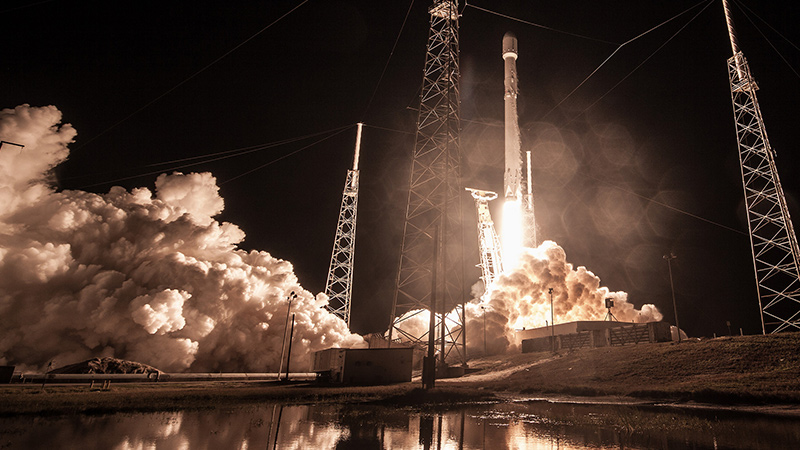Stay Up to Date
Submit your email address to receive the latest industry and Aerospace America news.
Iridium announces new SpaceX launch amid mystery of what went wrong with confidential satellite after Falcon 9 launch
The fate of the confidential U.S. satellite Zuma has captured the imagination of the space community and prompted unanswered questions over how the government will investigate the mission and prevent similar losses of taxpayer investment.
Stargazers miles from its launch on Jan. 7 in Florida on a SpaceX Falcon 9 rocket saw the first stage of the rocket separate from the second booster and land back at Cape Canaveral, as planned. All seemed well until the next day, when the Wall Street Journal reported the “spy satellite is presumed to be a total loss after it failed to reach orbit,” citing unnamed industry and government officials.
Zuma’s purpose and cost are secret, but the Pentagon is the likely launch customer given that the National Reconnaissance Office says Zuma is not its satellite.
The Defense Department declined to comment or confirm who, if anyone, will investigate. What’s certain is that the mission was expensive, given that the cost of a national security satellite during the past decade has typically ranged from $900 million to $3 billion each.
The House Strategic Forces Subcommittee Chairman Mike Rogers, R-Ala., sent me a statement noting that “space is a risky business” and saying “I remain committed to providing rigorous oversight that accounts for that risk and ensures that we can meet all of our national security space requirements as the Air Force looks to competitively procure space launch services in the future.”
During a Jan. 11 press conference, Defense Department spokeswoman Dana White deflected all inquiries about the confidential mission to SpaceX, which says the launch operations went as planned.
During a hearing of the House Space Subcommittee on Jan. 17 unrelated to Zuma, its chairman Rep. Brian Babin, R-Texas, pressed NASA, a Falcon 9 customer, and SpaceX representatives to share any information they might have publicly or in a classified hearing with lawmakers.
“If this is declared a mishap and we understand that it’s a mishap, NASA will be informed,” said NASA’s Bill Gerstenmaier, associate administrator for human exploration and operations in response to Babin’s questions, adding “we do not know the details of the mission.”
The Zuma mission is the third national security-related launch for SpaceX, so the company is keen to defend its reliability as a launch provider — which means it also wants to prove it can keep government secrets. The launch provider forwarded a statement from SpaceX President Gwynne Shotwell that said, “after review of all data to date, Falcon 9 did everything correctly.”
“If we or others find otherwise based on further review, we will report it immediately,” Shotwell said. “Since the data reviewed so far indicates that no design, operational or other changes are needed, we do not anticipate any impact on the upcoming launch schedule.”
Northrop Grumman, which built Zuma, declined to comment on whether it built the payload adapter, a mechanism tailored for each satellite to attach it to the second stage of the rocket.
“Because it was a classified payload, what typically happens is that the customer and the payload producer don’t want the rocket producer to even see the satellite,” says Matt Desch, CEO of communications satellite provider Iridium, and a SpaceX customer. “They can’t let the rocket supplier make the payload adapter that dispenses the satellite because if they did they would have to know things about the satellite.”
Payload adapters provided by SpaceX have released Iridium satellites from Falcon 9 rockets without issue, Desch says, adding that he is confident about the company’s due diligence. On Monday he announced that SpaceX aims to launch the fifth group of Iridium NEXT communications satellites at 8:19 a.m. Pacific time on March 18, from Vandenberg Air Force Base in California. This will be the fifth time a Falcon 9 will launch Iridium NEXT satellites.
That said, retired Air Force space officers told me there is no uniform approach for how payload adapters connect satellites with rockets on classified missions.
A Dutch pilot and amateur satellite trackers spotted the upper stage Falcon 9 rocket dumping leftover fuel as part of its safety routine two and a half hours after the launch on Jan. 7 to prepare the stage for deorbiting, says Marco Langbroek, a consultant on space situational awareness for the Royal Dutch Air Force. Langbroek says it is unclear whether Zuma was still attached. The Space-Track website contracted by the Air Force has cataloged the Zuma payload as USA 280 alongside other space objects, but includes no details, including whether it deorbited.
Regardless of what happened to Zuma or what its mission was, it’s certain that it was expensive. The total acquisition cost of the Space Based Infrared System constellation being developed by primary contractor Lockheed Martin to spot nuclear missile launches is estimated at $19.2 billion, or around $3 billion per satellite, according to a Government Accountability Office report published in June. The cost for Zuma would be similar if it had a comparable weight or mission goal. Langbroek says Zuma’s intended orbit flying over mostly ocean surfaces would be ideal for a radar satellite to monitor naval activity.
About Tom Risen
As our staff reporter from 2017-2018, Tom covered breaking news and wrote features. He has reported for U.S. News & World Report, Slate and Atlantic Media.
Related Posts
Stay Up to Date
Submit your email address to receive the latest industry and Aerospace America news.




